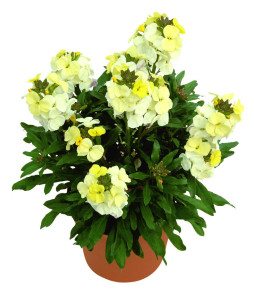
Perennial Solutions: Erysimum ‘Rysi Moon’
Erysimum is a class of early flowering perennials unfamiliar to many and probably underutilized by most. In recent years, plant selection and breeding efforts have given new life to wallflowers.
‘Rysi Moon’ is one of five cultivars in the Rysi series of erysimum bred by Kientzler, which is worth considering when designing a perennial program for spring. ‘Rysi Moon’ has large clusters of pure white flowers. Although it blooms in the early spring, the flowers are long lasting; the initial flush of blooms provides a solid four to five weeks of color and the flowers continue to develop providing color well into the summer months.
The evergreen plants remain compact, growing 12 inches high and 16 inches across. The plants are dense and well branched, providing an appealing appearance with lots of clusters of white flowers on compact stems. The evergreen foliage can tolerate some frost when acclimated to cold; however, ‘Rysi Moon’ is only hardy to Zone 7. Wallflowers are great plants for perennial borders but also are wonder components in mixed containers and patio pots.
With its early flowering and long lasting blooms, ‘Rysi Moon’ is a great candidate for early retail sales. If you haven’t grown erysimum in the past, consider giving this one a try.
Propagation
Erysimum ‘Rysi Moon’’ is vegetatively propagated by tip cuttings. It is patented, but unrooted cuttings are available for propagators to purchase and root.

of color.
The use of rooting compounds is not essential, but the rooting times can be reduced and the uniformity of rooting improved for erysimum when they are applied. If you elect to use rooting agents, dip the basal ends of the cuttings into a 750- to 1,000-ppm solution of indolebutyric acid (IBA). Stick the cuttings into liner flats containing pre-moistened well-drained propagation substrate.
Maintain moderate mist frequencies for the first two days of propagation, then slightly reduce the amount of misting being provided. Once the cuttings begin to develop roots, further reduce the misting frequency, removing it altogether once the cuttings can remain turgid throughout the day.
At seven to 10 days after sticking, it is beneficial to apply water-soluble fertilizers using 75- to 100-ppm nitrogen at each irrigation. Fungus gnat larvae can occasionally become problematic; a preventative program such as using beneficial nematodes (Steinernema feltiae) to control them is often sufficient. To promote a well-branched finished plant, it is beneficial to pinch the cuttings approximately four weeks after sticking. Liners take four to six weeks from sticking to become fully rooted and ready for transplanting.
Production
Erysimum ‘Rysi Moon’ is suitable for production in trade gallon or smaller sized containers. They prefer to be grown in a slightly moist, well-drained growing medium. When potting, the liners should be planted so the original soil line of the plug is even with the surface of the growing medium of the new container.
Although this cultivar branches freely, it is often beneficial to pinch them to promote lateral branching. Ideally, the liners should have been pinched a couple of weeks prior to transplanting. If the plants have not been pinched, they can
be pinched at planting or as needed during production. Avoid pinching or cutting them too low or they will not develop branches very well. Pinching should occur several weeks before the beginning of the vernalization period.
Erysimum prefer to be grown under light to moderate fertility regiments. Nutrients can be delivered using water-soluble or controlled-release fertilizers. Nutrients are commonly delivered using water soluble sources, providing 100 to 150 ppm using a constant liquid fertilizer program or 250 ppm as needed. Several growers incorporate low rates of controlled-release fertilizers into the growing mix before planting to effectively provide nutrients to containerized wallflowers. The pH of the media should be maintained between 5.8 and 6.4.
They generally require average amounts of irrigation. Erysimum should be kept slightly moist, but not saturated during production. When irrigation is necessary, I recommend watering thoroughly then allowing the soil to dry slightly between waterings.
With the compact growth habit of erysimum ‘Rysi Moon’, it is usually not necessary to manage plant height. Plant size can generally be maintained when plants are grown with adequate spacing between them. If the crops need to be toned, spray applications of 5-ppm uniconazole (Concise or Sumagic) are effective.
Insects and Diseases
Erysimum can generally be grown without the occurrence of cultural problems. However, they are susceptible to several diseases and insects during production. Aphids, spider mites and thrips are the most prevalent pests of wallflowers. The most common pathogens which may be observed on occasion includes Botrytis, downy mildew, powdery mildew, Rhizoctonia, rust diseases and Xanthomonas. None of these insect pests or plant pathogens require preventative control strategies. Growers can detect the presence of these problems through routine scouting programs and determine if and when control strategies are necessary.
Temperature and Scheduling
With its early season flowering, erysimum ‘Rysi Moon’ is usually marketed in the early spring. To obtain the fullest and highest quality containers, it is best to provide a bulking phase in the late summer or early fall prior to overwintering them. Allow six to 10 weeks for bulking in the fall.
‘Rysi Moon’ does require vernalization for flowering; a six to eight week cold period with temperatures below 40° F can be provided to plants in the final container or in large plug liners. After the plants are vernalized, they can be grown under natural lengths. They prefer to be grown under moderately cool temperatures with 24-hour average temperatures of 55 to 65° F. When they are grown at these temperatures, they can be forced into bloom in the spring in six to seven weeks.
Availability
Erysimum ‘Rysi Moon’ was brought to the market by Cultivaris.
Unrooted cuttings are available from Dümmen Orange. Rooted liners can be obtained from several reputable perennial propagators.


 Video Library
Video Library 




















